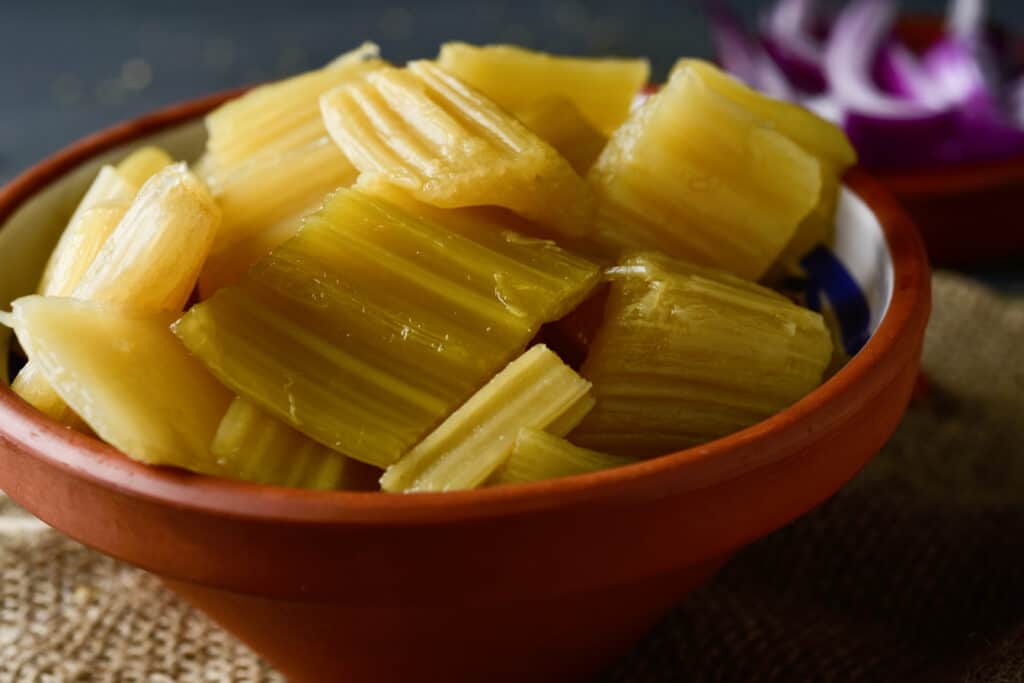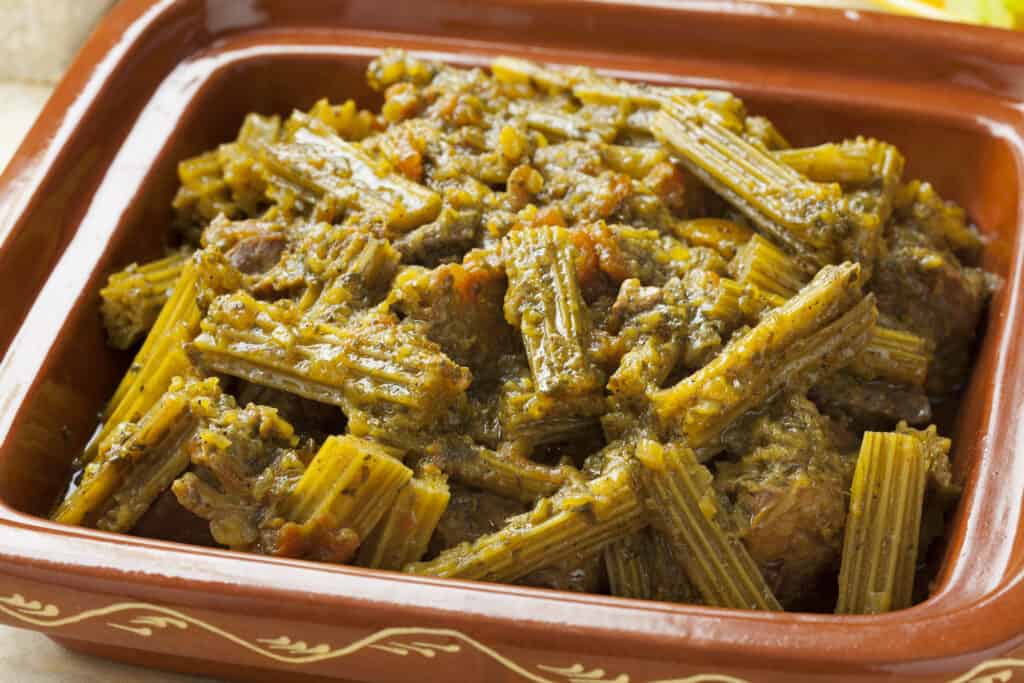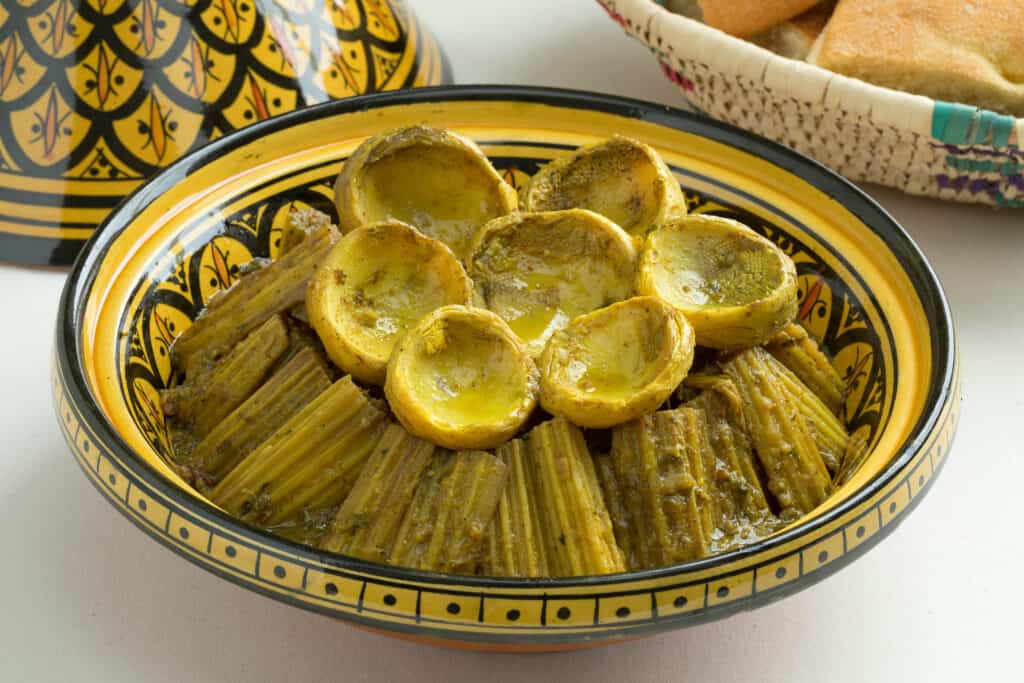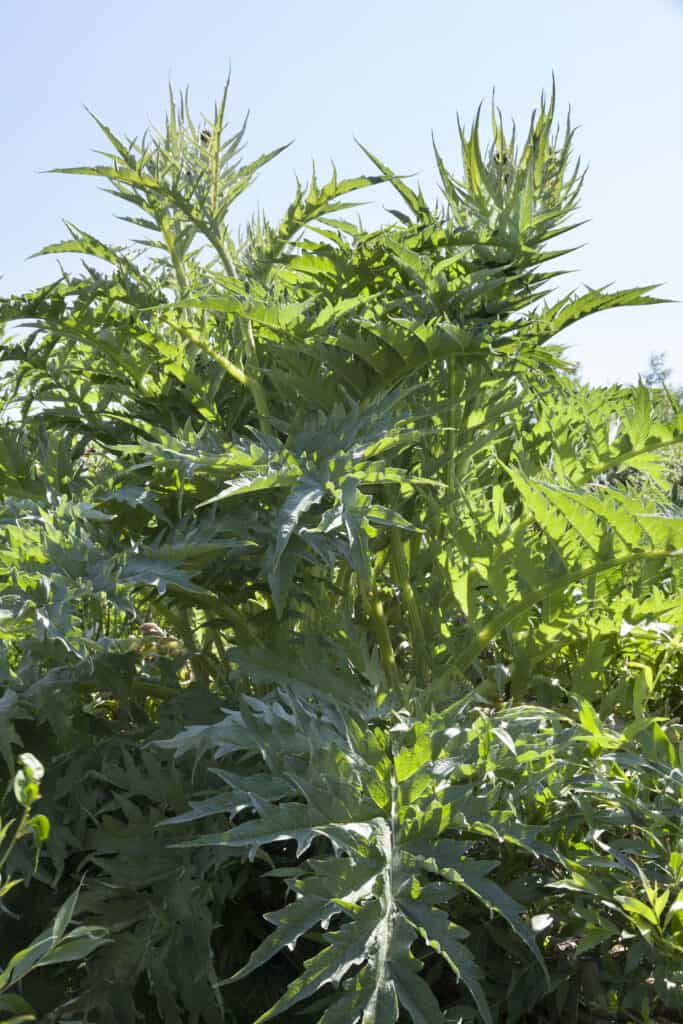Cardoon is related to the artichoke and looks much like an artichoke. Cardoon is prepared like asparagus and celery and is served as a vegetable side dish or added to soups or stews. Cooked it is soft and meaty.
Cardoon has a more bitter than sweet taste that hints of artichoke, asparagus, celery, and salsify.

Cardoon is available fresh and local from winter through early spring.
How to choose cardoon
- Look for cardoons with smaller stalks that are firm and have a dull-silvery, gray-green color. The outer stalks of larger bunches can be woody, hard, and covered with soft spikes.
- Avoid stalks that are wilting or browning—although the top of stalks that have had their upper leaves removed will brown slightly

How to store cardoon
- Place a damp paper towel at the base of each bunch then place the bunch in a plastic bag in the refrigerator.
- Cardoon will store for up to 2 weeks.
Cardoon serving suggestion
- Cardoon is prepared much like celery or asparagus both raw and cooked.
- Raw cardoon can be chopped into salads, but taste a piece to make sure it is not bitter. If raw cardoon is bitter, pre-cook the stalks then chill then serve.

Cardoon cooking suggestions
- Cardoon can be boiled, braised or baked.
- Remove the tough outer ribs. Cut the inner ribs to the size called for then soak them in a light lemon or lime water to prevent browning. Many recipes call for pre-cooking cardoon for 15-30 minutes in boiling water.
- Pre-cooking cardoon will remove the bitterness.
- In Italy, young cardoon is cut into strips, tossed with olive oil, salt, and pepper and then baked in a moderate oven. When the cardi is baked tender, it is removed from the oven and sprinkled with Parmesan cheese and served.
How to boil cardoon
These directions add a special touch to plain boiling celery.
- Clean and trim the cardoon and cut the stalks into small crescents
- Place the crescents in a pot and add just enough water to cover.
- Bring the water to a boil over medium-high heat and cook the cardoon until it is just tender, about 5 minutes.
- Drain away the water and add butter with salt and pepper to taste.
How to sauté cardoon
- Clean and trim the cardoon and cut the stalks into thin pieces
- Heat 6 or more tablespoons of unsalted butter in a sauté pan over medium heat.
- Add the cardoon and salt and pepper to taste.
- Cook shaking the pan occasionally until the cardoon is tender, about5 minutes.
Cardoon can be sautéed with other vegetables for added flavor.

How to oven-braise cardoon
- Clean and trim the cardoon and cut the stalks into pieces 2 inches long.
- Add 2 tablespoons of olive oil or butter to a large ovenproof skillet.
- Put the skillet on the stovetop over medium heat.
- When the oil or butter is melted, add the cardoon and cook stirring occasionally for 2 minutes.
- Sprinkle with salt and pepper to taste and add 1 cup of vegetable stock and bring to a boil.
- When the stock comes to a boil, transfer the skillet to the oven and cook until the cardoon is tender, about 15 minutes.
- Add liquid if it evaporates before the cardoon is tender.
- Serve hot or warm garnished with chopped parsley or fresh dill.

Get to know cardoon
- Cardoon is related to the artichoke. Both are edible members of the thistle family.
- Cardoon has silvery gray-green stalks that resemble a giant bunch of wide, flat celery. Unlike celery, the color of cardoon is dull, not bright, and its texture is subtle, not crisp.
- The name cardoon comes from the Latin carduus or the later French chardon—which means thistle.
- Cardoon is thought to have originated in the Mediterranean region where the Greeks and Romans considered it as an essential ingredient in a gourmet meal.
- Today, cardoon continues that regional popularity in France, Italy, Spain, Portugal, and the countries of North Africa. In Italy, cardoon is called cardoni. In Spain, the blanched stalks or ribs of the inner leaves of cardoon are used in cocido—a meat and vegetable stew.
The botanical name for cardoon is Cynara cardunculus.
Also of interest:
Related articles:
How to Plant Grow and Harvest Cardoon
Four Ways to Cook and Serve Cardoon
How to Plant and Grow Artichokes
How to Cook and Serve Artichokes
Artichokes and Mint Side Salad
Artichokes Steamed and Stuffed
Three Artichoke Dipping Sauces
Artichoke Growing Problems Troubleshooting
Articles of interest:
Best Herbs for Container Growing
Garden Planning Books at Amazon:
- Vegetable Garden Almanac & Planner
- Kitchen Garden Grower’s Guide Vegetable Encyclopedia
- Vegetable Garden Grower’s Guide
- Tomato Grower’s Answer Book
More kitchen tips:
Bring your harvest to the table. Kitchen prep tips and easy recipes for the vegetables you grow. Click below for vegetable prep and recipes you can use now.
- Almonds
- Apples
- Apricot
- Aprium
- Artichoke
- Arugula
- Asparagus
- Avocado
- Bamboo Shoots
- Banana
- Basil
- Beans, Dried
- Beans. Long
- Beans, Shell
- Beans, Snap
- Beets
- Bitter Melon
- Blackberry
- Bok Choy
- Broccoli
- Broccoli Raab
- Brussels Sprouts
- Cabbage
- Cardoon
- Carrots
- Cauliflower
- Celeriac
- Celery
- Chard
- Chayote Squash
- Cherimoya
- Cherries
- Chestnut
- Chickpea
- Chinese Cabbage
- Chives
- Cilantro
- Citron
- Clementine
- Collards
- Coriander
- Corn, Sweet
- Corn, Baby
- Corn Salad, Mache
- Cranberry
- Cress
- Cucumber
- Daikon
- Dandelion
- Dill
- Eggplant
- Endive, Belgian
- Endive and Escarole
- Fava Beans
- Fig
- Florence Fennel
- Garlic
- Ginger
- Grapefruit
- Grapes
- Guava
- Horseradish
- Jerusalem Artichoke
- Jicama
- Jujube
- Kale
- Kiwifruit
- Kohlrabi
- Kumquat
- Leeks
- Lemongrass
- Lemons
- Lettuce
- Lime
- Mache (Corn Salad)
- Mandarin Orange
- Mango
- Maple Syrup
- Marjoram
- Melons
- Michihili
- Mint
- Mizuna
- Mushrooms
- Mushrooms, Cremini
- Mustard Greens
- Napa Cabbage
- Nectarine
- Okra
- Olives
- Olive oil
- Onions
- Oranges
- Oregano
- Parsley
- Parsley Root
- Parsnips
- Passion Fruit
- Pawpaw
- Peaches
- Pears
- Peas, Garden Snap
- Peas, Snow
- Pei Tsai
- Peppers, Chili
- Peppers, Sweet
- Persimmon
- Pineapple
- Pineapple Guava
- Plantain
- Plums
- Pluots
- Pomegranate
- Potatoes
- Prickly Pear
- Pumpkin
- Quince
- Radicchio
- Radishes
- Raspberries
- Rosemary
- Rhubarb
- Rutabaga
- Sage
- Salsify
- Sauerkraut
- Savory
- Shallots
- Sorrel
- Spinach
- Squash, Summer
- Squash, Winter
- Strawberries
- Sunchokes
- Sunflower
- Sweet Potato
- Swiss Chard
- Tangerine
- Taro
- Tarragon
- Thyme
- Tomatillo
- Tomato
- Turnip
- Turnip Greens
- Yams



